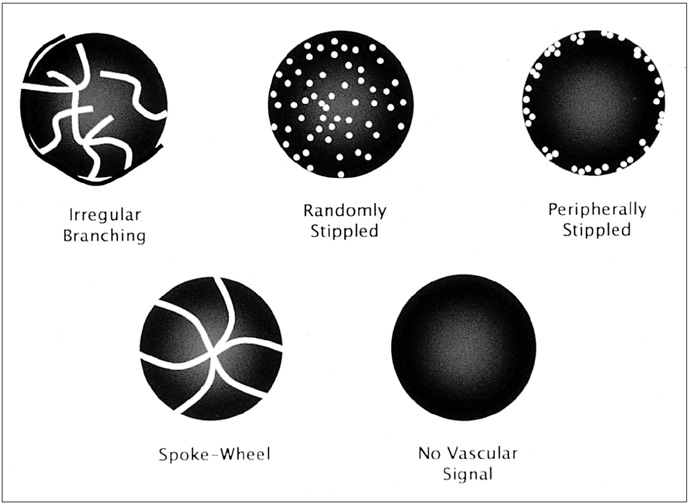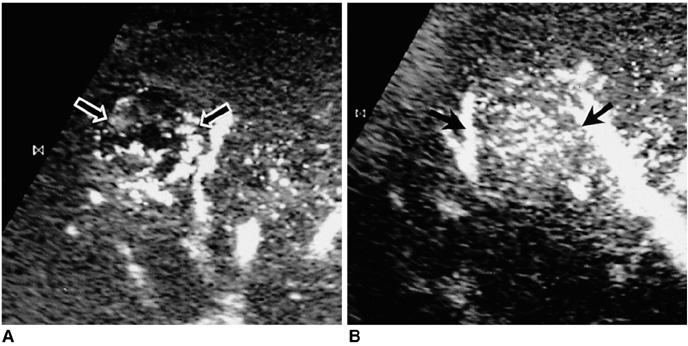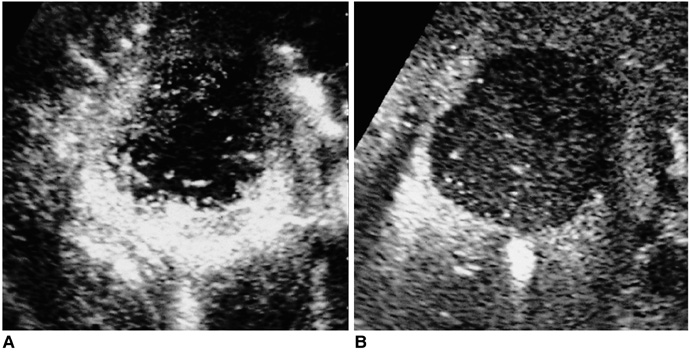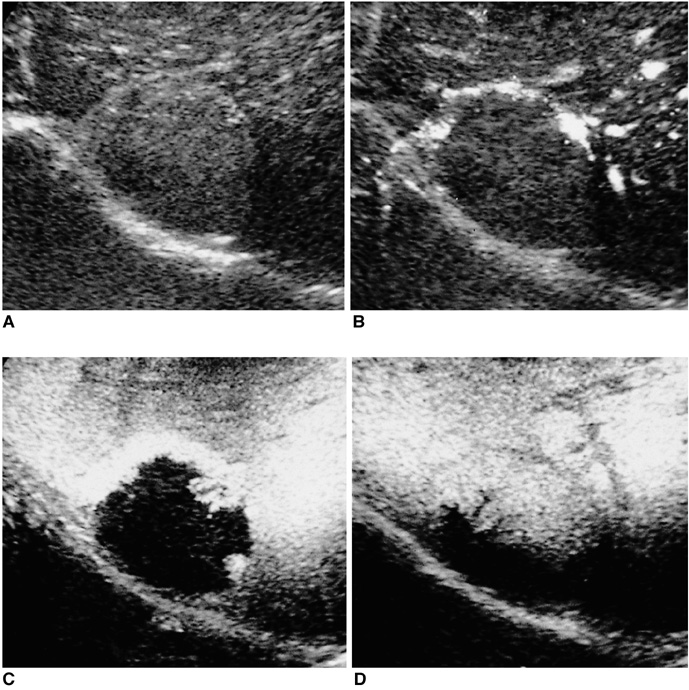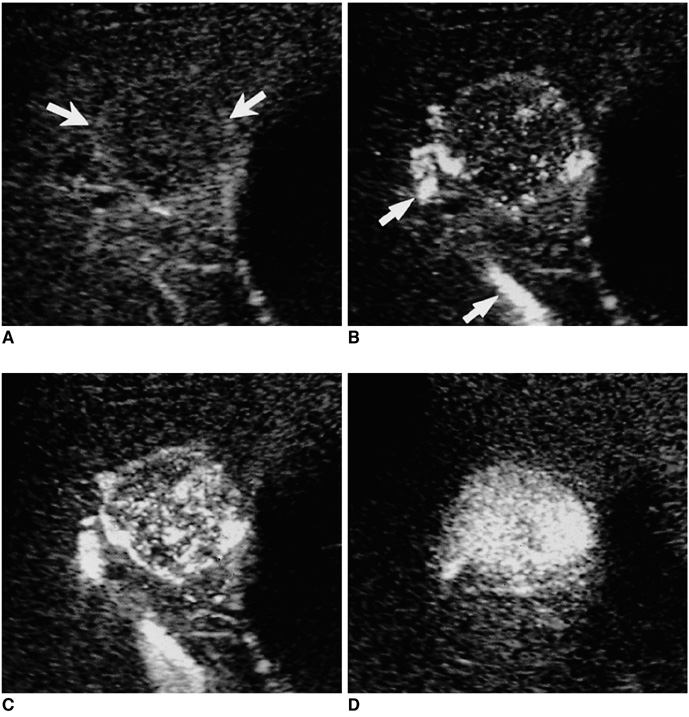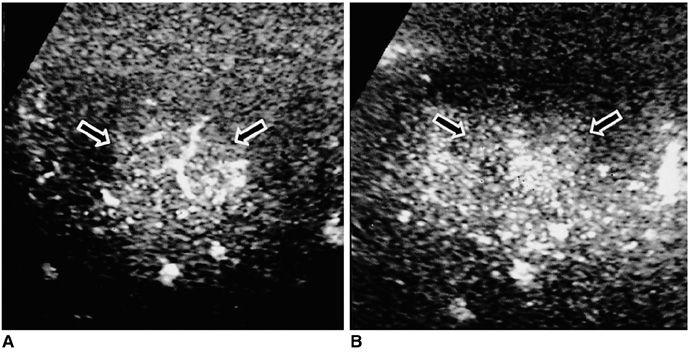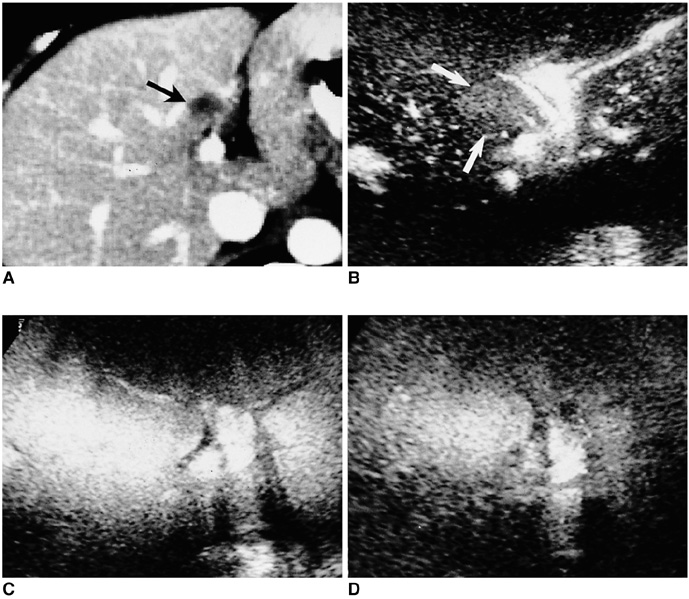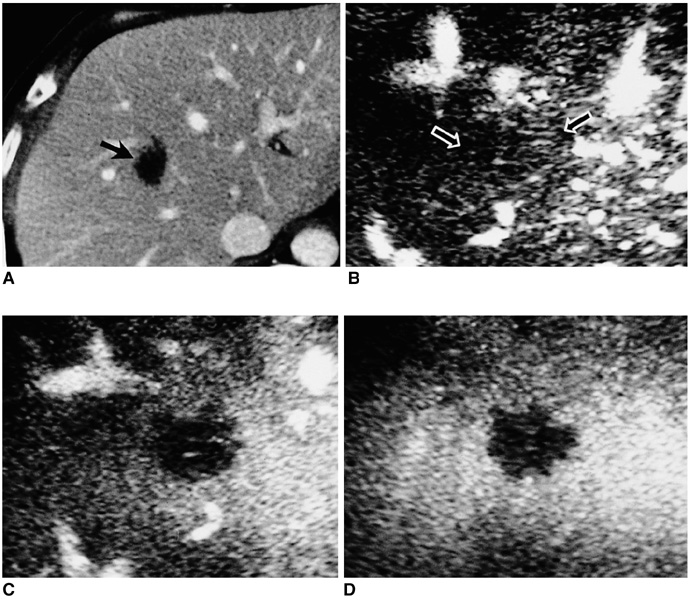Korean J Radiol.
2003 Jun;4(2):91-100. 10.3348/kjr.2003.4.2.91.
Focal Hepatic Lesions: Evaluation with Contrast-Enhanced Gray-Scale Harmonic US
- Affiliations
-
- 1Department of Radiology and Center for Imaging Science, Samsung Medical Center, Sungkyunkwan University School of Medicine, Seoul Korea. hklim@smc.samsung.co.kr
- 2Department of Radiology and Center for Liver Cancer, National Cancer Center, Seoul Korea.
- KMID: 1118811
- DOI: http://doi.org/10.3348/kjr.2003.4.2.91
Abstract
OBJECTIVE
To determine the findings of various focal hepatic lesions at contrast-enhanced gray-scale ultrasound (US) using a coded harmonic angio (CHA) technique and emphasizing lesion characterization. MATERIALS AND METHODS: The study involved 95 patients with 105 focal hepatic lesions, namely 51 hepatocellular carcinomas (HCCs), 22 metastases, 22 hemangiomas, four cases of focal nodular hyperplasia (FNH), and six nontumorous nodules. After the injection of a microbubble contrast agent (SH U 508A), gray-scale harmonic US studies using a CHA technique were performed with a combination of continuous scanning to assess the intratumoral vasculature (vascular imaging) and interval-delay scanning to determine the sequential enhancement pattern (acoustic emission imaging). Each imaging pattern was categorized and analyzed. RESULTS: At vascular imaging, 69% of HCCs (35/51) showed irregular branching vessels, while in 91% of metastases (20/22) a peripherally stippled pattern was observed. Intratumoral vessels were absent in 95% of hemangiomas (21/22) and all nontumorous lesions (6/6), while in 75% of FNHs (3/4) a spoke-wheel pattern was evident. At acoustic emission imaging, 71% of HCCs (36/51) showed heterogeneous enhancement and 86% (19/22) of metastases showed rim- or flame-like peripheral enhancement during the early phase, with washout occurring in all HCCs and metastases (100%, 73/73) during the late phase. In hemangiomas, enhancement was either peripheral and nodular (19/22, 86%) or persistent and homogeneous (3/22, 14%), and 75% of FNHs (3/4) became isoechoic during the late phase. CONCLUSION: At contrast-enhanced gray-scale US using a CHA technique, a period of continuous scanning depicted the intratumoral vasculature, and interval-delay scanning demonstrated the sequential enhancement pattern. The characteristic findings of various focal hepatic lesions were thus determined.
Keyword
Figure
Cited by 1 articles
-
Focal Hepatic Lesions: Contrast-Enhancement Patterns at Pulse-Inversion Harmonic US using a Microbubble Contrast Agent
Eun-A Kim, Kwon-Ha Yoon, Young Hwan Lee, Hye Won Kim, Seon Kwan Juhng, Jong Jin Won
Korean J Radiol. 2003;4(4):224-233. doi: 10.3348/kjr.2003.4.4.224.
Reference
-
1. Goldberg BB, Merton DA, Forsberg F, Liu J-B, Rawool N. Color amplitude imaging: preliminary results using vascular sonographic contrast agents. J Ultrasound Med. 1996. 15:127–134.2. Kim TK, Han JK, Kim AY, Park SJ, Choi BI. Signal from hepatic hemangiomas on power Doppler US: real or artefactual? Ultrasound Med Biol. 1999. 25:1055–1061.3. Choi BI, Kim TK, Han JK, Kim AY, Seong CK, Park SJ. Vascularity of hepatocellular carcinoma: assessment with contrast-enhanced second-harmonic versus conventional power Doppler US. Radiology. 2000. 214:381–386.4. Kim TK, Han JK, Kim AY, Choi BI. Limitations of characterization of hepatic hemangiomas using an ultrasound contrast agent (Levovist) and power Doppler ultrasound. J Ultrasound Med. 1999. 18:737–743.5. Wilson SR, Burns PN, Muradali D, Wilson JA, Lai X. Harmonic hepatic US with microbubble contrast agent: initial experience showing improved characterization of hemangioma, hepatocellular carcinoma, and metastasis. Radiology. 2000. 215:153–161.6. Dill-Macky MJ, Burns PN, Khalili K, Wilson SR. Focal hepatic masses: enhancement patterns with SH U 508A and pulse-inversion US. Radiology. 2002. 222:95–102.7. Tanaka S, Ioka T, Oshikawa O, Hamada Y, Yoshioka F. Dynamic sonography of hepatic tumors. AJR Am J Roentgenol. 2001. 177:799–805.8. Kim TK, Choi BI, Han JK, Hong HS, Park SH, Moo SG. Hepatic tumors: contrast agent-enhancement patterns with pulse-inversion harmonic US. Radiology. 2000. 216:411–417.9. Burns PN, Wilson SR, Simpson DH, Chin CT, Lai X. Harmonic interval delay imaging: a new ultrasound contrast method for imaging the blood pool volume in the liver. Radiology. 1998. 209(P):189.10. Burns PN, Wilson SR, Muradali D, Powers JE, Fritzsch TT. Intermittent US harmonic contrast-enhanced imaging and Doppler improve sensitivity and longevity of vessel detection. Radiology. 1996. 201(P):159.11. Ding H, Kudo M, Onda H, et al. Evaluation of posttreatment response of hepatocellular carcinoma with contrast-enhanced coded phase-inversion harmonic US: comparison with dynamic CT. Radiology. 2001. 221:721–730.12. Jang HJ, Lim HK, Lee WJ, Kim SH, Kim KA, Kim EY. Ultrasonographic evaluation of focal hepatic lesions: comparison of pulse inversion harmonic, tissue harmonic, and conventional imaging techniques. J Ultrasound Med. 2000. 19:293–299.13. Albrecht T, Hoffman CW, Schettler S, et al. B-mode enhancement at phase-inversion US with air-based microbubble contrast agent: initial experience in humans. Radiology. 2000. 216:273–278.14. Kim JH, Kim TK, Kim BS, et al. Depiction of typical enhancement pattern of hepatic hemangiomas: coded harmonic angio US with microbubble contrast agent. J Ultrasound Med. 2002. 21:141–148.15. Furuse J, Maru Y, Mera K, et al. Visualization of blood flow in hepatic vessels and hepatocellular carcinoma using B-flow sonography. J Clin Ultrasound. 2001. 29:1–6.16. Ding H, Kudo M, Onda H, Suetomi Y, Minami Y, Maekawa K. Hepatocellular carcinoma: depiction of tumor parenchymal flow with intermittent harmonic power Doppler US during the early arterial phase in dual-display mode. Radiology. 2001. 220:349–356.17. Lee JY, Choi BI, Han JK, Kim AY, Shin SH, Moon SG. Improved sonographic imaging of hepatic hemangioma with contrast-enhanced coded harmonic angiography: comparison with MR imaging. Ultrasound Med Biol. 2002. 28:287–295.
- Full Text Links
- Actions
-
Cited
- CITED
-
- Close
- Share
- Similar articles
-
- Hepatic Hemangiomas: Spectrum of US Appearances on Gray-scale, Power Doppler, and Contrast-Enhanced US
- Radiofrequency Ablation of Liver Cancer: Early Evaluation of Therapeutic Response with Contrast-Enhanced Ultrasonography
- Usefulness of the Hepatic Vein Transit Time Measured by Contrast-enhanced Gray-scale Harmonic Imaging in the Differentiation of Liver Cirrhosis and Chronic Hepatitis
- Contrast-enhanced ultrasonography for the evaluation of malignant focal liver lesions
- Role of contrast-enhanced harmonic endoscopic ultrasonography (EUS) and EUS elastography in pancreatic lesions

